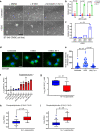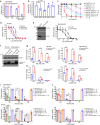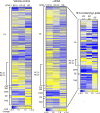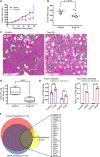Ferroptotic cell death triggered by conjugated linolenic acids is mediated by ACSL1
- PMID: 33854057
- PMCID: PMC8046803
- DOI: 10.1038/s41467-021-22471-y
Ferroptotic cell death triggered by conjugated linolenic acids is mediated by ACSL1
Abstract
Ferroptosis is associated with lipid hydroperoxides generated by the oxidation of polyunsaturated acyl chains. Lipid hydroperoxides are reduced by glutathione peroxidase 4 (GPX4) and GPX4 inhibitors induce ferroptosis. However, the therapeutic potential of triggering ferroptosis in cancer cells with polyunsaturated fatty acids is unknown. Here, we identify conjugated linoleates including α-eleostearic acid (αESA) as ferroptosis inducers. αESA does not alter GPX4 activity but is incorporated into cellular lipids and promotes lipid peroxidation and cell death in diverse cancer cell types. αESA-triggered death is mediated by acyl-CoA synthetase long-chain isoform 1, which promotes αESA incorporation into neutral lipids including triacylglycerols. Interfering with triacylglycerol biosynthesis suppresses ferroptosis triggered by αESA but not by GPX4 inhibition. Oral administration of tung oil, naturally rich in αESA, to mice limits tumor growth and metastasis with transcriptional changes consistent with ferroptosis. Overall, these findings illuminate a potential approach to ferroptosis, complementary to GPX4 inhibition.
Conflict of interest statement
Ulrike Rennefahrt is a former employee of Metanomics Health, GmbH. Marcus Conrad is an inventor on patents for some of the compounds described herein, and shareholder of ROSCUE Therapeutics GmbH. The remaining authors declare no competing interests.
Figures









Similar articles
-
Inhibition of mitochondrial genome-encoded mitomiR-3 contributes to ZEB1 mediated GPX4 downregulation and pro-ferroptotic lipid metabolism to induce ferroptosis in breast cancer cells.Free Radic Biol Med. 2025 Jul;234:151-168. doi: 10.1016/j.freeradbiomed.2025.04.019. Epub 2025 Apr 14. Free Radic Biol Med. 2025. PMID: 40239722
-
Lipid peroxidation-induced ferroptosis as a therapeutic target for mitigating neuronal injury and inflammation in sepsis-associated encephalopathy: insights into the hippocampal PEBP-1/15-LOX/GPX4 pathway.Lipids Health Dis. 2024 Apr 29;23(1):128. doi: 10.1186/s12944-024-02116-x. Lipids Health Dis. 2024. PMID: 38685023 Free PMC article.
-
GPX4 at the Crossroads of Lipid Homeostasis and Ferroptosis.Proteomics. 2019 Sep;19(18):e1800311. doi: 10.1002/pmic.201800311. Epub 2019 May 31. Proteomics. 2019. PMID: 30888116 Review.
-
Inhibition of ACSL4 attenuates ferroptotic damage after pulmonary ischemia-reperfusion.FASEB J. 2020 Dec;34(12):16262-16275. doi: 10.1096/fj.202001758R. Epub 2020 Oct 18. FASEB J. 2020. PMID: 33070393
-
Ferroptosis Inducers as Promising Radiosensitizer Agents in Cancer Radiotherapy.Curr Radiopharm. 2024;17(1):14-29. doi: 10.2174/0118744710262369231110065230. Curr Radiopharm. 2024. PMID: 37974441 Review.
Cited by
-
Ferroptosis: a critical player and potential therapeutic target in traumatic brain injury and spinal cord injury.Neural Regen Res. 2023 Mar;18(3):506-512. doi: 10.4103/1673-5374.350187. Neural Regen Res. 2023. PMID: 36018155 Free PMC article. Review.
-
The AMPK-related kinase NUAK2 suppresses glutathione peroxidase 4 expression and promotes ferroptotic cell death in breast cancer cells.Cell Death Discov. 2022 May 6;8(1):253. doi: 10.1038/s41420-022-01044-y. Cell Death Discov. 2022. PMID: 35523770 Free PMC article.
-
Ferroptosis turns 10: Emerging mechanisms, physiological functions, and therapeutic applications.Cell. 2022 Jul 7;185(14):2401-2421. doi: 10.1016/j.cell.2022.06.003. Cell. 2022. PMID: 35803244 Free PMC article. Review.
-
Adverse Crosstalk between Extracellular Matrix Remodeling and Ferroptosis in Basal Breast Cancer.Cells. 2023 Aug 30;12(17):2176. doi: 10.3390/cells12172176. Cells. 2023. PMID: 37681908 Free PMC article.
-
Validation of ferroptosis in canine cancer cells to enable comparative oncology and translational medicine.bioRxiv [Preprint]. 2024 Apr 30:2024.04.28.591561. doi: 10.1101/2024.04.28.591561. bioRxiv. 2024. PMID: 38746359 Free PMC article. Preprint.
References
-
- Friedmann-Angeli, J. P., Miyamoto, S. & Schulze, A. Ferroptosis: the greasy side of cell death. Chem. Res. Toxicol.32, 362–369 (2019). - PubMed
Publication types
MeSH terms
Substances
Grants and funding
LinkOut - more resources
Full Text Sources
Other Literature Sources
Molecular Biology Databases
Research Materials
Miscellaneous

